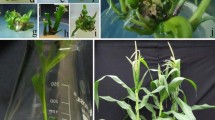Summary
Multiple shoot formation in cotyledonary callus of Indian mustard (Brassica juncea cv. Prakash) was induced on modified MS media supplemented with high cytokinin (kinetin or zeatin) and low IAA concentrations. Complete plants were obtained on prolonged incubation of shoots on the same medium. 6-Benzyladenine alone or in combination with IAA or NAA did not support plantlet regeneration. A total of 71 plants were transferred to greenhouse. The seed, however, could be collected from 37 plants only. The seed was sown in the field to evaluate the material for somaclonal variation in R1 generation. Data were recorded for yield, plant height, number of primary branches, siliqua number, 1,000 seed weight and oil content. Somaclonal lines showed tremendous amount of variation for all the characters studied. A number of plants in this generation showed significantly higher yield and/or other improved agriculturally important characteristics as compared to the control. A line with dwarf plant type was also identified. A number of plants were selected from this generation and carried forward to R2 generation. Most of these lines bred true in R2 generation. The material seems to be very promising for future breeding programmes.
Similar content being viewed by others
References
Chandler, S.F. & T.A., Thorpe, 1987. Proline accumulation and sodium sulfate tolerance in callus cultures of Brassica napus L. cv. Westar. Plant Cell Reports 6: 176–179.
Evans, D.A. & W.R., Sharp, 1986. Somaclonal and gametoclonal variation. In: D.A., Evans, W.R., Sharp, P.V., Ammirato (Eds), Handbook of plant cell culture, Volume 4. Macmillan Publishing Company, New York, p. 97–132.
Evans, D.A., W.R., Sharp & H.P., Medina-Filho, 1984. Somaclonal and gametoclonal variation. Amer. J. Bot. 71: 759–774.
Fazekas, G.A., P.A., Sedmach & M.V., Palmer, 1986. Genetic and environmental effects on in vitro shoot regeneration from cotyledon explants of Brassica juncea. Plant Cell, Tissue and Organ Culture 6: 177–180.
George, L., V., Abraham, D.R., Suryavanshi, A.T., Sipahimalani & V.T., Srinivasan, 1987. Yield, oil content and fatty acid composition evaluated in androgenetic plants in Brassica juncea. Plant Breeding 98: 72–74.
George, L. & P.S., Rao, 1980. In vitro regeneration of mustard plants (Brassica juncea var. Rai-5) of cotyledon explants from non-irradiated, irradiated and mutagen treated seed. Ann. Bot. 46: 107–112.
George, L. & P.S., Rao, 1983. Yellow-seeded variants in in vitro regenerants of mustard (Brassica juncea cross var. Rai-5). Plant Sci. Lett. 30: 327–330.
Grout, B.W.W. & P., Crisp, 1980. The origin and nature of shoots propagated from cauliflower roots. J. Hort. Sci. 55: 65–70.
Gupta, S.K., K., Dhawan & T.P., Yadav, 1985. Estimation of oil content by wide-line NMR. Oil Crops Newsletter 2: 17–21.
Heinz, D.J., M., Krishnamurthi, L.G., Nickell & A., Maretzki, 1977. Cell, tissue and organ culture in sugarcane improvement. In: J., Reinert & Y.P.S., Bajaj (Eds), Applied and fundamental aspects of plant cell, tissue and organ culture. Springer-Verlag, Berlin, p. 3–17.
Hoffman, F., 1978. Mutation and selection of haploid cell culture systems of rape and rye. In: A.W., Alfermann & E., Reinhard (Eds), Production of natural comounds by cell culture methods. Gesellschaft für Strahlen- and Umweltfor-schung, München, p. 319–329.
Hoffman, F., E., Thomas & G., Wenzel, 1982. Anther culture as a breeding tool in rape. ii. Progeny analysis of androgenetic lines and induced mutants from haploid cultures. Theor. Appl. Genet. 61: 225–232.
Karp, A. & S.W.J., Bright, 1985. On the causes and origins of somaclonal variation. Oxford Surveys of Plant Molucular & Cell Biology 2: 199–234.
Krishnamurthi, M., 1981. Sugarcane improvement through tissue culture and review of progress. In: A.N., Rao (Ed.), Tissue culture of economically important plants. Asian Network for Biological Science, Singapore, p. 70–77.
Larkin, P.J., R.I.S., Brettel, S.A., Ryan, P.A., Davies, M.A., Pallotta & W.R., Scowcroft, 1985. Somaclonal variation: impact on plant biology and breeding strategies. In: P., Day, M., Zaitlin & A., Hollaender (Eds), Biotechnology in plant science. Academic Press, New York, p. 83–100.
Larkin, P.J. & W.R., Scowcroft, 1981. Somaclonal variation — a novel source of variability from cell culture for plant improvement. Theor. Appl. Genet. 60: 197–214.
Lefort-Buson, M., 1981. The use of heterosis in winter rape seed (Brassica napus L.). In: A.G. Inra (Ed.), Quantitative genetics and breeding methods, European Association for Research on Plant Breeding, p. 59–69.
Liu, M.C. & W.H., Chen, 1978. Tissue and cell culture as aids to sugarcane breeding. 2. Performance and yield potential of callus derived lines. Euphytica 27: 273–282.
Murashige, T. & F., Skoog, 1962. A revised medium for rapid growth and bioassay with tobacco tissue cultures. Physiol. Plant. 15: 473–493.
Schaeffer, G.W., 1982. Recovery of heritable variability in anther-derived doubled-haploid rice. Crop Sci. 22: 1160–1164.
Schaeffer, G.W., F.T., SharpeJr. & P.B., Cregan, 1984. Variation for improved protein and yield from rice anther culture. Theor. Appl. Genet. 67: 383–389.
Secor, G.A. & J.F., Shepard, 1981. Variability of protoplast-derived potato clones. Crop Sci. 21: 102–105.
Wenzel, G., B., Foroughi-Wehr, W., Friedt, F., Köhler & T., Oo, 1985. Cell and tissue culture as supplementary tool in plant breeding: Exemplified in potato, oilseed rape and barley. Hereditas (suppl.) 3: 15–25.
Wenzel, G., F., Hoffman, E., Thomas, 1977. Anther culture as a breeding tool in rape. 1. Ploidy level and phenotype of androgenetic plants. Z. Pflanzenzücht. 78: 149–155.
Zong-Xiu, S., Z., Cheng-Zhang, Z., Kang-Le, Q., Xiu-Fang & F., Ya-Ping, 1983. Somaclonal genetics of rice, Oryza sativa L. Theor. Appl. Genet. 67: 67–73.
Author information
Authors and Affiliations
Rights and permissions
About this article
Cite this article
Jain, R.K., Sharma, D.R. & Chowdhury, J.B. High frequency regeneration and heritable somaclonal variation in Brassica juncea . Euphytica 40, 75–81 (1989). https://doi.org/10.1007/BF00023300
Received:
Accepted:
Issue Date:
DOI: https://doi.org/10.1007/BF00023300




